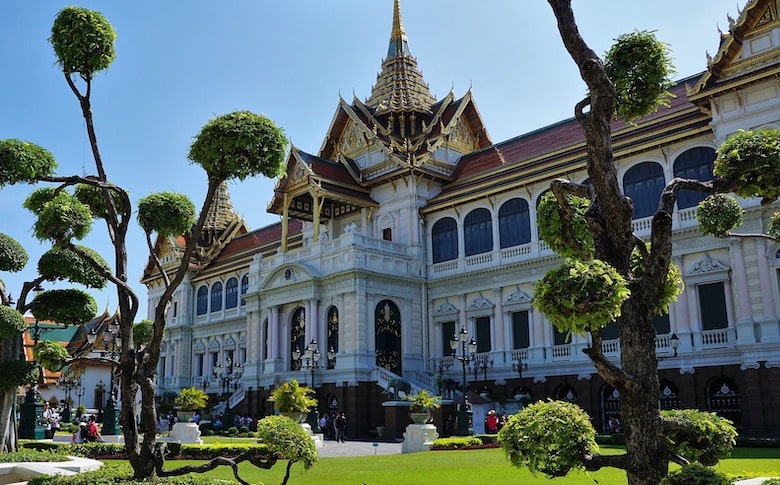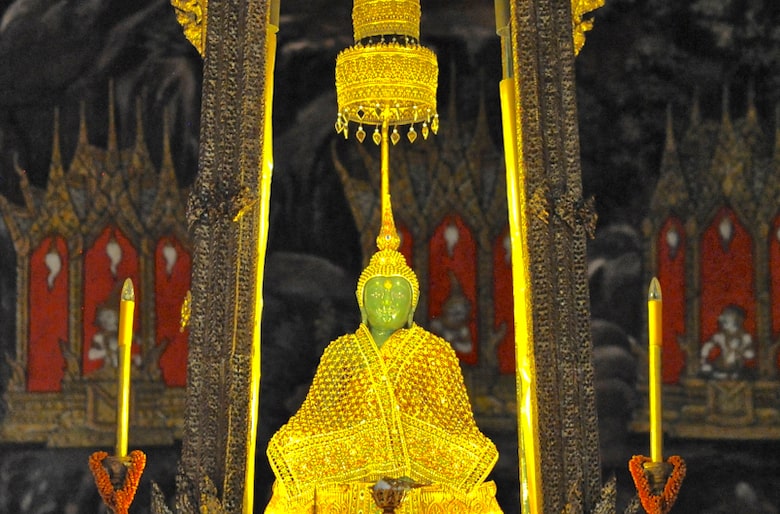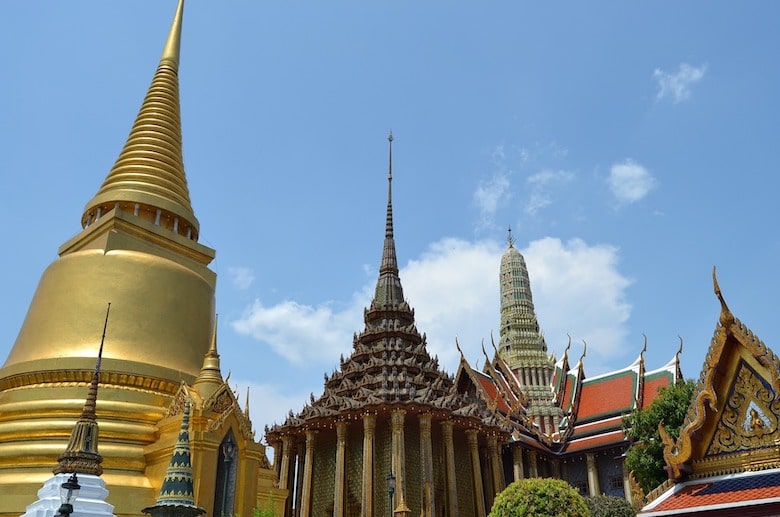
The main building of the Grand Palace, Bangkok's first royal residence.
When Bangkok was made the capital of Thailand in the late 1700s, a grand royal residence was built, resulting in an outstanding architectural masterpiece of spires and gold-plated walls. It was a self-sufficient city-within-a-city, housing government offices, temples, and the official homes of the king and queen, all protected by fortified walls and gates.
The complex suffered alterations over time, mainly the replacement of wooden constructions with brick structures, and the addition of architectural styles of each period, including a few European (neoclassical) influences. Although the royal family moved out in 1925 (it now lives in the district of Dusit), the interior of the main palace building is currently used for official and religious ceremonies (including the coronation of kings), and often welcomes foreign heads of state.
The most sumptuously-decorated building is the Dusit Throne Hall, crowned with a tiered spire and housing a teak throne that’s considered a masterpiece of Thai art. Another throne hall, the Chakri, is the most “palatial” and was added in 1882. It followed a European or neoclassical design, but kept a Thai-style roof.
The Wat Phra Kaew, or Temple of the Emerald Buddha, is still used in religious ceremonies, but is mostly visited by the thousands of tourists who stop to admire the country’s most important Buddha statue. It’s inside the complex’s most sacred building, with exterior doors and windows inlaid with mother-of-pearl designs, and sits above a fantastic golden altar. It’s dressed in one of three costumes, depending on the season.

The Emerald Buddha in the palace's temple
Another of the temple’s striking buildings is that of the library housing Buddhist scriptures, which is closed to the public. Its splendid exterior features bronze elephant statues and memorials to all the kings of the present Chakri dynasty.
Surrounding the temple complex is a cloister known as the Ramakien Gallery, decorated with 178 panels from the late 1700s, depicting the ancient legend of the Ramakien, an epic tale about the triumph of good versus evil.
Before you enter the Grand Palace and the temple, make sure your shoulders and legs are covered. If not, you’ll be given a shirt or sarong to cover up.

Wat Phra Kaew, the Temple of the Emerald Buddha
Insider Tips
-The entire Grand Palace complex closes quite early, at 3:30pm, so plan to visit early.
-Without a guide, you may miss the significance and important features of many of the buildings, so you may want to go on a tour.
-One of the most common scams in Bangkok is a taxi or tuk-tuk driver telling tourists, as they approach the palace, that the monument is closed on that day, and offering to take them on a tour of temples and shops in the area instead. Refuse the offer -- the palace is always open.
How to get to the Grand Palace
Take the boat to Tha Chang pier or the MRT subway to Sanam Chai station.
Visitor's Guide
Opening times: 8:30am - 3:30pm
Tickets: 500 bahts (for the entire complex -- palace and temple) or join a tour: Grand Palace and Temples Tour
Attractions by the Grand Palace
Visit Wat Pho (the Temple of the Reclining Buddha), the National Museum, Wat Mahathat and the Amulet market, and (on the other side of the river, almost opposite) Wat Arun (the Temple of Dawn).
Stay by the Grand Palace
Surprisingly, there aren't many hotels by the Grand Palace, but there is a highly-rated and well-designed property on the riverfront (facing Wat Arun), the romantic Inn a Day
Also by the river and just a few feet from the palace is Sala Rattanakosin
